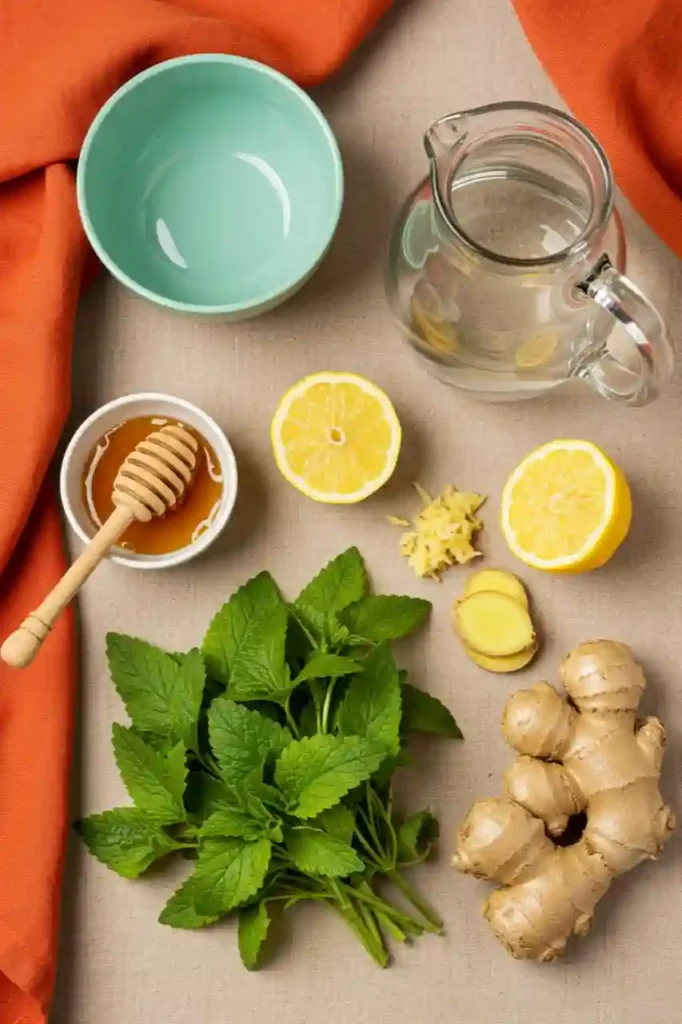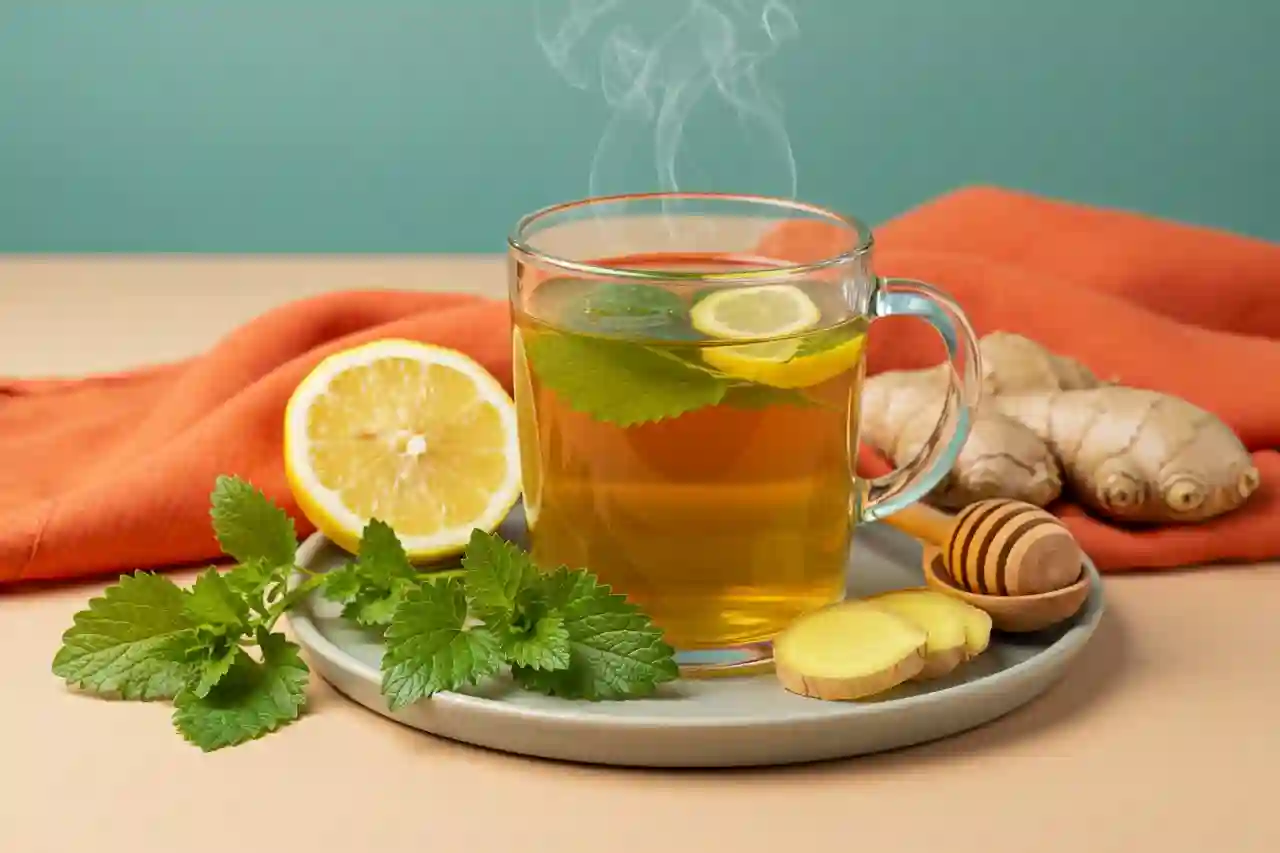I first brewed this lemon balm recipe on a restless spring evening, when the garden was bursting with calming herbs and my mind refused to settle. One sip and I felt it, a wave of warmth, like the tension melting from my shoulders. Over time, this simple tea became more than a comfort. It supported better digestion, eased late-night cravings, and helped me shed a few stubborn pounds, all without changing much else.
As a chef, I’ve returned to lemon balm again and again because it offers more than flavor. It’s soothing, grounding, and remarkably easy to prepare. Whether you’re here for wellness, weight loss, or just a better way to unwind, this recipe is a gentle place to start.
Print
Lemon Balm Recipe for Weight Loss
- Total Time: 10 minutes
- Yield: 2 cups
- Diet: Vegetarian
Description
This lemon balm recipe is a calming herbal tea that supports digestion, reduces bloating, and eases stress-related cravings. Perfect for evening rituals or gentle detox routines.
Ingredients
- 1 cup fresh lemon balm leaves (or 1 tbsp dried)
- 1 tsp grated fresh ginger (optional)
- 1 tsp fresh lemon juice (juice of ½ lemon)
- 2 cups filtered water
- 1 tsp honey (optional)
Instructions
- Bring water to a boil, then let it cool for 30 seconds.
- Place lemon balm and ginger in a teapot or infuser.
- Pour hot water over herbs and cover immediately.
- Let steep for 8 minutes.
- Strain into a mug.
- Add lemon juice and honey if desired, then serve warm.
Notes
- Use dried lemon balm if fresh isn’t available—just 1 tablespoon.
- For iced tea, let cool, refrigerate, and serve over ice.
- Avoid aluminum containers for steeping; use glass, ceramic, or stainless steel.
- Store extra tea in the fridge up to 24 hours. Reheat gently before serving.
- Prep Time: 2 minutes
- Cook Time: 8 minutes
- Category: Drink
- Method: Steeped
- Cuisine: Herbal
5 Proven Benefits of Lemon Balm for Weight Loss
Lemon balm (Melissa officinalis) has long been valued in herbal traditions, but its benefits extend beyond calm. What makes it helpful for weight loss isn’t a magic fix, it’s how it works with your body’s natural rhythms.
1. Supports Digestion and Reduces Bloating
A sluggish digestive system can make you feel heavier than you are. Lemon balm acts as a carminative, meaning it helps relieve gas and bloating. According to herbalist Rosalee de la Forêt, it also stimulates gentle digestive activity, making you feel lighter without aggressive detoxing.
2. Eases Stress-Induced Cravings
Stress is a hidden driver behind emotional eating and weight gain. Lemon balm has mild anxiolytic properties, in other words, it helps reduce anxiety without sedating you. A study published in Phytotherapy Research found it significantly improved mood and calmness in adults. A clinical study in Phytotherapy Research showed that lemon balm extract can reduce anxiety and promote calm without causing drowsiness, which supports healthier eating behavior. Fewer cravings, better choices.
3. Improves Sleep Quality
Better sleep supports hormonal balance, including leptin and ghrelin, the hormones that control hunger and fullness. Drinking lemon balm tea in the evening can promote deeper rest, which in turn helps with fat metabolism and appetite regulation.
4. Natural Mild Diuretic Effect
Lemon balm encourages the body to release excess water without depleting essential minerals. While water loss isn’t fat loss, reducing water retention can make you feel lighter and less puffy, especially around the belly area.
5. Promotes a Ritual of Slowing Down
This benefit isn’t listed on most health sites, but I’ve seen its power firsthand. Making and sipping tea signals your body to pause. That mindfulness, just 10 minutes without screens or stress, often leads to better eating habits and fewer impulsive snacks.
How to Make This Lemon Balm Recipe (Step-by-Step)
This recipe is simple to prepare and deeply soothing. Whether you’re using lemon balm for relaxation or as part of your weight loss routine, the infusion process draws out its best qualities. The optional ginger adds warmth, while lemon and honey round out the flavor.
Ingredients
| Ingredient | Amount |
|---|---|
| Fresh lemon balm leaves | 1 cup, lightly packed (or 1 tbsp dried) |
| Grated fresh ginger (optional) | 1 teaspoon |
| Lemon juice | 1 teaspoon (juice of ½ lemon) |
| Filtered water | 2 cups |
| Honey (optional) | 1 teaspoon |

Instructions
Time needed: 10 minutes
Use this gentle method to steep the lemon balm without damaging its calming compounds. Avoid overboiling or long steeping times, which can turn the tea bitter.
- Heat the Water
First, bring the filtered water to a boil. Then remove it from the heat and allow it to sit for 30 seconds so it cools slightly.
- Prepare the Herbs
Meanwhile, place the lemon balm and ginger into a teapot, French press, or infuser. This combination creates a fragrant, warming base.
- Steep the Tea
Next, gently pour the heated water onto the herb blend. Immediately cover the vessel to trap the steam and essential oils. Let it steep for 8 minutes.
- Strain and Pour
After steeping, strain the liquid into a mug or heatproof glass. Be sure to discard the used herbs or compost them if you prefer eco-friendly practices.
- Add Final Touches
Now stir in fresh lemon juice and honey, if desired. These additions not only boost flavor but also offer light digestive support.
- Serve and Enjoy
Finally, drink slowly while the tea is still warm. For best results, sip in a quiet setting without distractions.

Pro Tips
- Fresh vs. Dried: If you’re using dried lemon balm, remember to reduce the quantity to just 1 tablespoon. Since dried herbs are more concentrated, steeping time stays the same.
- Flavor Adjustments: For a milder cup, simply steep the tea for 5 minutes instead of 8. On the other hand, for a stronger brew, extend steeping to 10 minutes, but avoid going past that.
- Chill for Iced Tea: To make an iced version, let the brewed tea cool to room temperature. Then refrigerate for at least an hour and serve it over ice with a slice of lemon or a sprig of mint.
- Storage: If you have leftovers, store them in a sealed glass jar in the refrigerator for up to 24 hours. Be sure to shake before reheating.
- Avoid Aluminum: Always steep herbal tea in ceramic, glass, or stainless steel containers. Aluminum can react with plant compounds, which may change the taste and reduce effectiveness.
When and How to Drink for the Best Results
To get the most benefit from this lemon balm recipe for weight loss, timing matters just as much as the ingredients. While the tea itself supports digestion and calm, pairing it with the right moment in your day can enhance its natural effects.
Drink it in the evening to reduce stress eating
If you often find yourself reaching for snacks after dinner, try replacing that habit with a warm cup of lemon balm tea. Drinking it after your last meal can help reduce cortisol levels, curb cravings, and improve sleep, all of which support a healthier metabolism.
Use it in the morning to start digestion gently
Although lemon balm is often thought of as a nighttime tea, it can also work well in the morning. When paired with lemon juice and ginger, this tea becomes a light detox drink that gently wakes up the digestive system without caffeine.
Drink before meals for appetite control
About 20 minutes before a meal, a small cup of this tea can help reduce mindless overeating. The lemon and ginger stimulate digestive juices, while lemon balm’s calming effect helps you eat more slowly and consciously.
Be consistent for lasting results
Drinking lemon balm tea once won’t trigger dramatic change. However, consistent use, such as one to two cups daily, can support long-term weight goals when combined with healthy habits. If you’re using it for stress relief or bloating, daily use is safe for most people, according to herbal studies.
Cycle the use to avoid plateaus
After three or four weeks of daily use, consider taking a break for a few days. This natural cycling approach helps your body reset and can improve your sensitivity to herbal benefits over time.

Lifestyle Habits to Boost the Benefits
Lemon balm tea can support your goals, but for best results, it works alongside daily habits that reduce inflammation, regulate appetite, and support emotional balance. These small shifts don’t require perfection, just consistency.
Stay hydrated throughout the day
Drinking enough water is one of the simplest ways to help your body eliminate excess sodium and reduce water retention. Herbal teas like lemon balm count toward your fluid intake, but you’ll still want to aim for 6–8 cups of plain water daily. Add a pinch of sea salt or lemon to improve absorption.
Walk after meals to support digestion
Even a slow 10-minute walk after eating helps lower blood sugar and reduce post-meal bloating. When paired with lemon balm’s digestive support, this habit makes a powerful impact over time. Plus, walking helps regulate appetite and reduce stress hormones.
Reduce added sugars and alcohol
Excess sugar and alcohol can increase cravings and interfere with sleep, two things lemon balm works to improve. If you’re trying to lose weight, consider cutting back gradually. For example, swap sugary sodas with chilled herbal tea or sparkling water infused with fruit.
Practice mindfulness during meals
Eating while distracted often leads to overeating. Try to sit down, chew slowly, and engage your senses. This improves digestion and helps you notice when you’re full. Drinking your tea before or after meals can naturally reinforce this ritual.
Support sleep with an evening wind-down routine
Quality sleep plays a vital role in metabolism and fat loss. Lemon balm tea is a natural addition to a calming bedtime routine. For added benefit, turn off screens 30 minutes before bed and do light stretching or breathwork while sipping your tea.
Is Lemon Balm Safe for Daily Use?
Lemon balm is widely considered safe for most people, especially when used in tea form. However, as with any herb, daily use should come with a few smart precautions, especially if you plan to drink it regularly for weight loss or stress relief.
Standard dosage for tea
Most herbalists recommend drinking 1 to 2 cups of lemon balm tea per day. Each cup typically contains 1 tablespoon of dried lemon balm or 1 cup of fresh leaves. This amount is gentle enough for daily use without causing side effects for the average adult.
When to avoid lemon balm
According to WebMD, people with thyroid conditions, those who are pregnant or breastfeeding, or anyone on sedatives should consult a healthcare provider before regular use.
- Thyroid disorders: Lemon balm may affect thyroid hormone levels.
- Pregnancy or breastfeeding: Safety data is limited, so it’s best to consult a qualified practitioner.
- Medication interactions: Lemon balm may interfere with sedatives, thyroid medications, and certain antivirals.
Short-term vs. long-term use
Lemon balm is ideal for short-term support during periods of high stress, poor sleep, or digestive discomfort. If using daily for more than four weeks, take a break for a few days each month to help your body stay responsive to the herb.
Signs it’s not working for you
If you notice grogginess, digestive upset, or fogginess after drinking lemon balm tea, reduce your dosage or stop altogether. These are rare but possible when sensitive individuals consume larger amounts or combine it with other calming herbs.
Always consult if unsure
If you take prescription medications or manage a chronic condition, speak with a qualified healthcare provider or herbalist before using lemon balm regularly. Herbal remedies are powerful, and when used wisely, they can complement conventional care safely.
Nutrition & Cost Breakdown
When you make herbal tea at home, you’re not just gaining control over ingredients, you’re also keeping things affordable and nourishing. This lemon balm recipe is light, functional, and budget-friendly.
Nutritional Overview (Per 1 Cup Serving)
While herbal tea doesn’t contain macronutrients like a full meal, it still offers trace elements and functional benefits. Here’s a breakdown based on typical quantities:
| Nutrient | Approximate Value |
|---|---|
| Calories | 8 kcal (without honey) |
| Carbohydrates | 2g (from lemon and optional honey) |
| Sugar | 1g (from lemon or honey) |
| Caffeine | 0 mg |
| Sodium | Trace |
Note: Nutritional values may vary based on herb strength and optional ingredients.
Cost Breakdown (Per Serving)
Making lemon balm tea at home is far more affordable than pre-packaged detox blends or herbal teas sold in stores. Here’s what one serving may cost using common prices:
| Ingredient | Estimated Cost |
|---|---|
| Fresh lemon balm leaves | $0.25 (homegrown: free) |
| Grated ginger (optional) | $0.05 |
| Lemon juice | $0.10 |
| Honey (optional) | $0.15 |
| Filtered water | Negligible |
| Total | $0.40 – $0.55 |
Pro Tip: If you grow your own lemon balm or buy herbs in bulk, the cost per cup drops even further, often under 25 cents.
FAQs About Lemon Balm
Not directly, but it may help reduce bloating, ease stress, and support digestion, all of which can flatten the stomach over time. When paired with a healthy diet and exercise, lemon balm tea can assist gentle weight loss efforts.
Use fresh lemon balm in teas, infused waters, salad dressings, or herbal syrups. It pairs well with lemon, mint, and honey. You can also add it to fruit salads or use it in fish dishes for a light citrusy note.
Steep 1 cup fresh (or 1 tbsp dried) lemon balm in 2 cups hot water for 8 minutes. Add lemon juice, ginger, or honey if desired. Drink warm or chill it for an iced version. It’s calming and easy to make.
Yes, 1 to 2 cups per day is generally safe for most people. Avoid if you have thyroid issues or take certain medications. Take short breaks after a few weeks of daily use to maintain its effect. According to WebMD, lemon balm may interact with sedatives or thyroid medications, so long-term use should be discussed with a healthcare provider.
Final Thoughts from Chef Natalie
If you’ve made it this far, you’re not just looking for another tea recipe, you’re looking for a ritual that brings calm, clarity, and gentle support for your body. This lemon balm recipe has become a steady part of my evenings. It’s not about quick fixes, but about creating space for your body to feel good again.
Whether you’re sipping it after dinner to curb late-night cravings, or starting your morning with a mindful moment, this tea offers more than flavor. It’s a quiet, nourishing act of self-care.
I often enjoy it alongside a light plant-forward meal like our carrot ribbon salad, or follow it with a refreshing mango turmeric smoothie in the morning. If you’re exploring detox-style recipes, the Japanese pink salt weight loss drink is another great addition to your routine. And for something beautiful and calming, try our naturally vibrant butterfly pea lemonade.
Start small, stay consistent, and let the benefits build over time.


How do you make lemon balm tea detox
It’s very easy to make. Just steep fresh or dried lemon balm leaves in hot water for 5-7 minutes, then add a little lemon juice and honey if you like. This simple tea helps detox the body and supports natural weight loss.
Hello, What drink burns the most belly fat?
That’s a great question! I actually shared a full recipe on this, it’s called “Japanese Pink Salt Weight Loss Drink”, a simple mix that helps detox and reduce belly fat naturally.